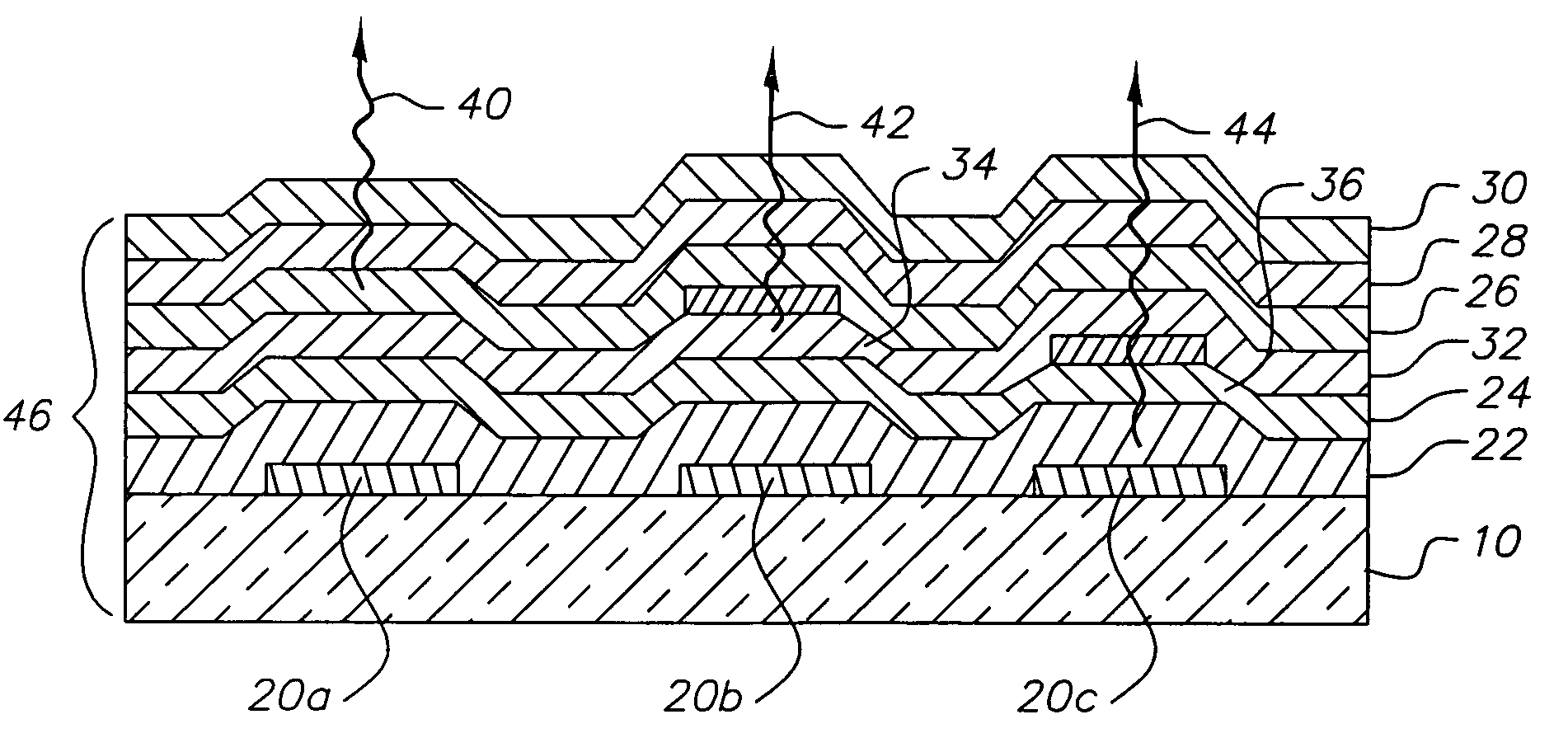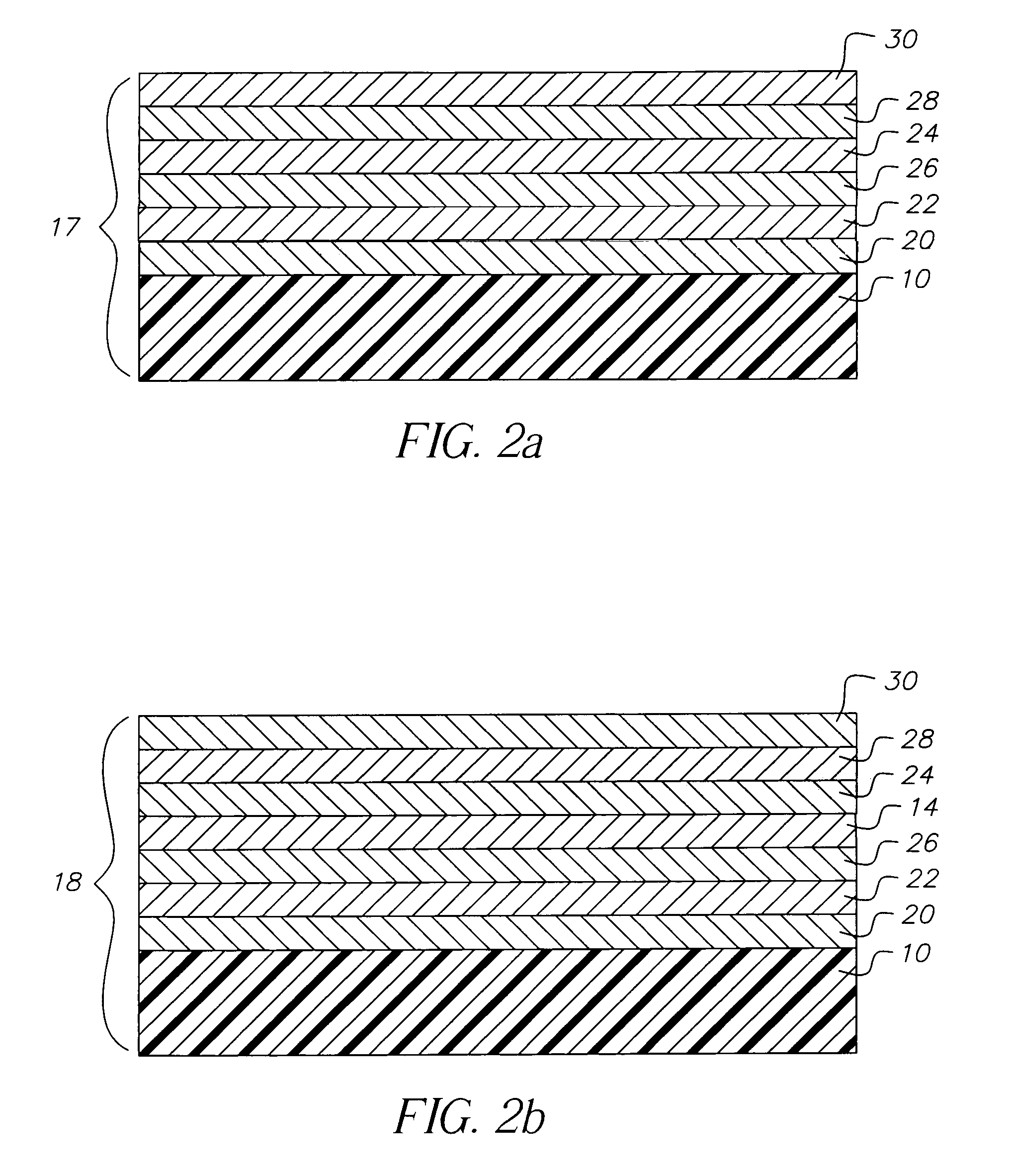Using hole- or electron-blocking layers in color OLEDS
a color oled, electron-blocking technology, applied in the manufacture of electrode systems, electric discharge tubes/lamps, discharge tubes luminescnet screens, etc., can solve the problems of adding to the time and complexity of manufacture, and achieve the effect of reducing the number of alignment and patterned transfer steps, reducing the number of handling steps, and simplifying the manufacturing process of color oled devices
- Summary
- Abstract
- Description
- Claims
- Application Information
AI Technical Summary
Problems solved by technology
Method used
Image
Examples
example 1 (
INVENTIVE EXAMPLE)
[0148]An OLED device with an electron-blocking layer satisfying the requirements of the invention was constructed in the following manner.
1. A clean glass substrate was vacuum-deposited with indium tin oxide (ITO) through a mask to form a pattern of transparent electrodes of 40 to 80 nm thickness.
2. The above-prepared ITO surface was treated with a plasma oxygen etch, followed by plasma deposition of a 0.1 nm layer of a fluorocarbon polymer (CFx) as described in U.S. Pat. No. 6,208,075.
[0149]3. The above-prepared substrate was further treated by vacuum-depositing a 40 nm layer of 4,4′-bis[N-(1-naphthyl)-N-phenylamino]biphenyl (NPB) as a hole-transporting layer followed by a 15.3 nm layer of of 2-tert-butyl-9,10-bis(2-naphthyl)anthracene (TBADN) with 2% 4-(dicyanomethylene)-2-t-butyl-6-(1,1,7,7-tetramethyljulolidyl-9-enyl)-4H-pyran (DCJTB) (a red dopant).
4. A coating of 30 nm of 1,1-bis(4-di-p-tolylaminophenyl)cyclohexane (TAPC) as the electron blocker was evaporati...
example 3 (
INVENTIVE EXAMPLE)
[0152]An OLED device with an electron-blocking layer satisfying the requirements of the invention was constructed in the manner described in Example 1, except Step 3 was performed as follows:
[0153]3. The above-prepared substrate was further treated by vacuum-depositing a 40 nm layer of 4,4′-bis[N-(1-naphthyl)-N-phenylamino]biphenyl (NPB) as a hole-transport layer followed by a 20.4 nm layer of of ALQ with 2% 4-(dicyanomethylene)-2-t-butyl-6-(1,1,7,7-tetramethyljulolidyl-9-enyl)-4H-pyran (DCJTB) (a red dopant).
example 5 (
INVENTIVE EXAMPLE)
[0155]An OLED device with an electron blocker deposited by laser thermal transfer and satisfying the requirements of the invention was constructed in the following manner.
1. Onto a polyimide donor support element film having a thickness of 104 microns, a coating of 60 nm of chromium metal was evaporatively deposited.
2. A further coating of 30 nm of TAPC was evaporatively deposited on the above donor support element.
3. A clean glass substrate was vacuum-deposited with indium tin oxide (ITO) through a mask to form a pattern of transparent electrodes of 40 to 80 nm thickness.
4. The above-prepared ITO surface was treated with a plasma oxygen etch, followed by plasma deposition of a 0.1 nm layer of a fluorocarbon polymer (CFx) as described in U.S. Pat. No. 6,208,075.
[0156]5. The above-prepared substrate was further treated by vacuum-depositing a 40 nm layer of 4,4′-bis[N-(1-naphthyl)-N-phenylamino]biphenyl (NPB) as a hole-transporting layer followed by a 30.6 nm layer o...
PUM
| Property | Measurement | Unit |
|---|---|---|
| work function | aaaaa | aaaaa |
| wavelengths | aaaaa | aaaaa |
| wavelengths | aaaaa | aaaaa |
Abstract
Description
Claims
Application Information
 Login to View More
Login to View More - R&D
- Intellectual Property
- Life Sciences
- Materials
- Tech Scout
- Unparalleled Data Quality
- Higher Quality Content
- 60% Fewer Hallucinations
Browse by: Latest US Patents, China's latest patents, Technical Efficacy Thesaurus, Application Domain, Technology Topic, Popular Technical Reports.
© 2025 PatSnap. All rights reserved.Legal|Privacy policy|Modern Slavery Act Transparency Statement|Sitemap|About US| Contact US: help@patsnap.com



